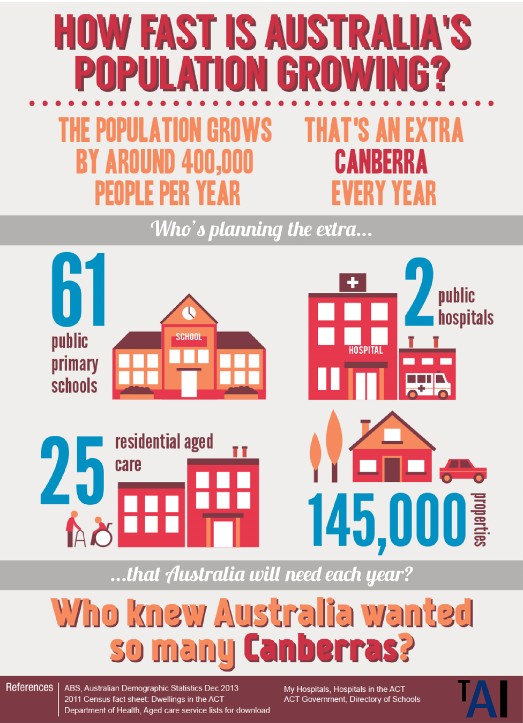The Grattan Institute continues to spruik the ‘enormous’ so-called fiscal benefits of immigration, claiming that federal and state budgets could be $38 billion better-off over the next decade if the skilled migrant intake was boosted by 40,000:
Migration provides big benefits to the Australian economy – not least since skilled migrants pay much more in taxes than they draw on in services. Grattan Institute modelling suggests that increasing the size of the permanent intake from 160,000 to 200,000, and allocating those extra visas to skilled workers, could offer a $38 billion boost to federal and state governments combined over the next decade.
I rubbished Grattan’s fantasy fiscal benefits last week, which runs counter to the empirical evidence of the 15 years leading up to the pandemic:
Australia ran its biggest ever ‘skilled’ migration program in the 15 years leading up to the pandemic, and what did it achieve? Crush-loaded hospitals, schools, roads, trains, utilities, chronic housing shortages, you name it. And Australians are paying more for infrastructure and services than ever (think toll roads).
This alone should tell you that the fiscal benefits of mass immigration are largely illusionary. They only arrive if our governments refuse to provide the necessary funding of infrastructure and services to cope with the exploding population. Hence the chronic crush-loading.
Moreover, the primary reason why our governments waste copious amounts of money on infrastructure projects like the $125 billion Suburban Rail Loop or WestConnex is to keep pace with Australia’s exploding population due to immigration.
So tell me again: how are we better off financially from mass immigration?
To its credit, Grattan has at least acknowledged that lifting the migrant intake would send rents higher, worsening housing affordability:
It’s a matter of simple logic that increasing the population without building more housing will worsen our housing affordability woes.
Any increase in migration levels must go hand in hand with concerted action on housing supply…
We estimate that increasing the annual migrant intake by 40,000 a year would, over a decade, push rents up by up to 5 per cent. Lower-income renters would be hit hardest.
Accordingly, Grattan calls for Australia to bulldoze our suburbs into higher density and build “an extra 50,000 homes each year for the next decade”.
Leaving aside the impossibility of achieving Grattan’s dwelling construction targets – which would require the biggest construction boom this nation has ever seen and would pull resources from other areas of the economy – “a matter of simple logic” would also require Australia to ramp-up its investment in hospitals, schools, transport, energy and water, and other economic and social infrastructure to keep pace with the biggest immigration intake in this nation’s history.
The below graphic from The Australia Institute highlights the kind of investment that would be required every year to meet Grattan’s immigration fetish:

Big Australia immigration requires massive investment.
Where would the funds come from to build this infrastructure? And how would Australia possibly meet its emissions reductions targets when it is adding so many energy users every year and building so many homes and infrastructure to accommodate them?
Surely the costs associated with growing the nation’s population like a science experiment would more than offset Grattan’s mythical $38 billion fiscal benefits? It certainly did in the years leading up to the pandemic.
Instead of listening to Grattan’s myopic fiscal view of immigration, the last word should go to long-time (15-year) chief of the Productivity Commission, Gary Banks:
One has to question whether, federal budget repair aside, attempts to revive immigration to the extent forecast would be sensible from a national interest perspective. While Treasury is perhaps understandably bullish, the Productivity Commission has provided a more nuanced assessment. This suggests that, under realistic assumptions, immigration does little for either participation or productivity nationally in the long term, with income gains in per capita terms small and largely skewed to migrants themselves.
Moreover, while highly skilled migrants are good for the economy, and sectors like mining in particular, and should be encouraged, the average skill level for the intake as a whole in recent years has not been high.
When externalities such as congestion and housing affordability are taken into account, I’d suggest that the optimal level of net immigration for Australia could be closer to Treasury’s forecast in the first IGR of 90 000 than the latest one. Where it ends up is unclear. But what is clear is that immigration policy is too important to be devised primarily on fiscal grounds or in relative seclusion.
Truer words have never been written.
Sadly, the concept of cost-benefit analysis escapes the Grattan Institute, the Australian Treasury and most economists.

